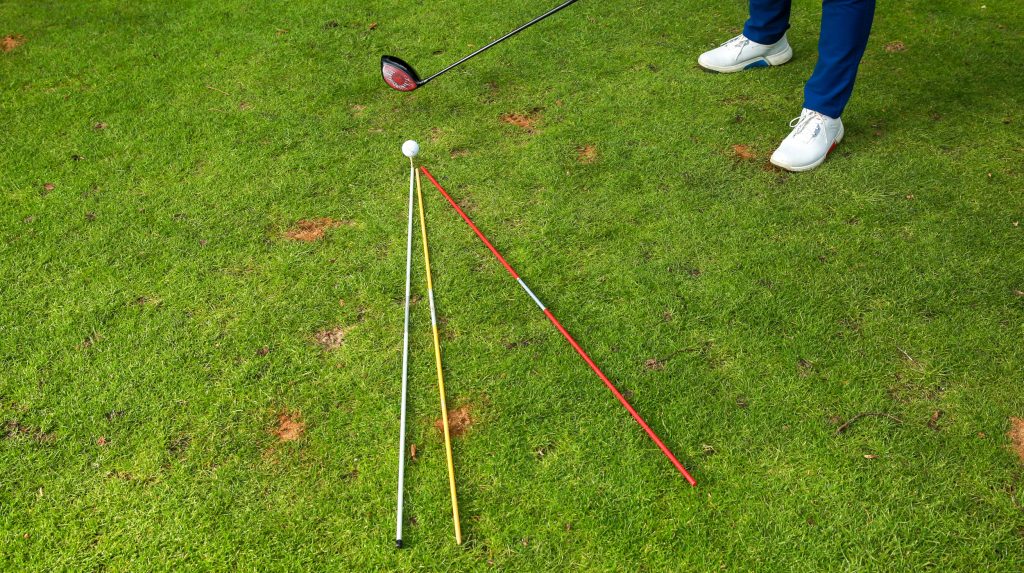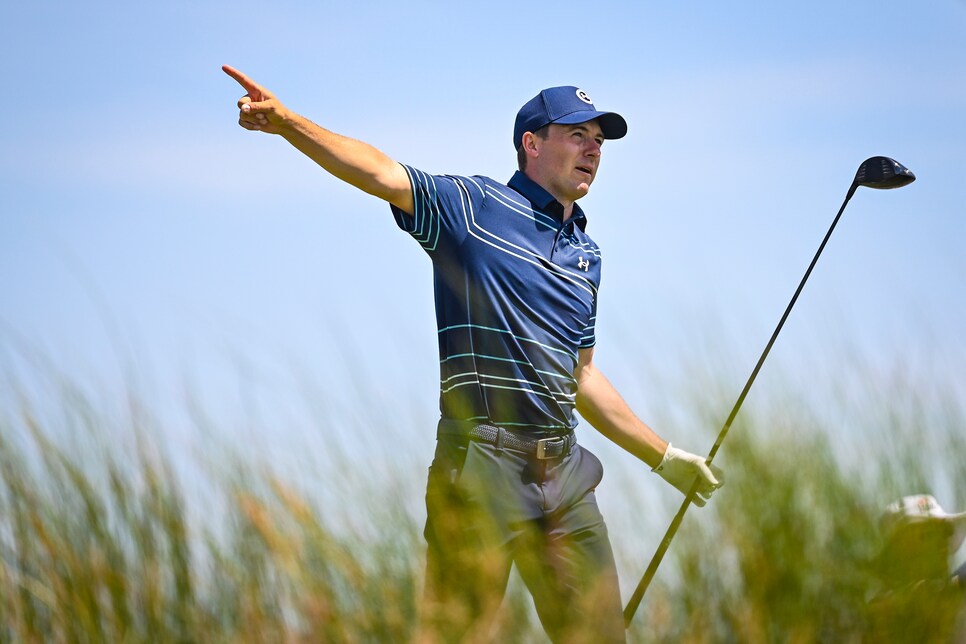A slice is one of the most common issues golfers face, especially with the driver. It’s the shot that veers to the right (for right-handed players) and often results in lost distance, frustration, and a poor scorecard. While many golfers have experienced this frustrating outcome, understanding the physics behind the slice, as well as the causes and effective methods to correct it, can go a long way in improving your game.
In this blog, we will break down the “what” and “why” behind the slice, explore its causes and consequences, and provide practical exercises and tips for training and correcting the slice. All of this will be explained through a lens of biomechanics, anatomy, and the physics of the golf swing, allowing you to grasp a deeper understanding of how to fix your slice once and for all.
What Is a Slice and Why Does It Happen?
At its core, a slice is a ball flight that curves dramatically to the right (for right-handed golfers) or to the left (for left-handed golfers). This happens because of an imbalance between the angle of the clubface and the path of the club during impact. Simply put, the clubface is open in relation to the path of the swing at impact, which imparts sidespin on the ball and sends it off course.
The Physics Behind the Slice: Face Angle vs. Club Path
To better understand the mechanics of the slice, let’s dive into the physics involved. The primary factors at play are the clubface angle and the club path. These two elements, when not aligned properly, create the conditions for a slice.
- Clubface Angle: The angle of the clubface in relation to the target line at impact. If the face is open (pointing to the right of the target for right-handed players), it will impart left-to-right spin on the ball. This is the most significant contributor to the slice.
- Club Path: The direction in which the clubhead is moving at impact. A path that is from outside to inside (known as an over-the-top swing path) causes the club to come down steeply, creating a significant side spin when combined with an open clubface.
When the clubface is open to the club path at impact, it creates a situation where the ball spins clockwise (for right-handed players) around its vertical axis, causing the ball to curve dramatically to the right. In simple terms, it’s the combination of these two factors — an open clubface and an incorrect swing path — that gives rise to the dreaded slice.
The Causes of a Slice
Understanding the causes behind the slice is crucial to fixing it. Below, we’ll outline some common reasons why golfers tend to slice their drives:
1. Incorrect Grip
A grip that is too weak, where the hands are rotated too far to the left on the club (for right-handed players), can lead to an open clubface at impact. This often causes the slice. The grip controls the initial positioning of the hands and wrists, so a weak grip will encourage the hands to rotate counterclockwise during the swing, leaving the clubface open and increasing the chances of a slice.
2. Over-the-Top Swing Path
An “over-the-top” swing path is when the club is swung outside the target line on the downswing and then cuts across the ball. This happens when the hands or arms lead the club too much, resulting in an outside-to-inside path. This type of path is commonly associated with a steep angle of attack, causing the clubface to remain open at impact and create side spin that causes the ball to curve right.
3. Poor Body Rotation
A lack of proper body rotation — particularly through the hips and torso — can cause the golfer to rely too much on the arms to initiate the downswing. When the arms lead the swing, the clubface can be left open, creating an off-path swing motion that leads to a slice. Ideally, the body should rotate in harmony with the arms to create a natural and square impact position.
4. Open Stance
A golfer who sets up with an open stance (where the feet and body are aligned left of the target) may unintentionally lead to an open clubface at impact. The open stance encourages an outside-to-inside swing path, which, when combined with an open clubface, results in the dreaded slice.
5. Ball Position
If the ball is too far forward in the stance (toward the front foot), the golfer may struggle to square the clubface properly at impact. This can lead to a variety of issues, including an open clubface that exacerbates the slice. A ball that is positioned too far back in the stance may lead to a hook, but too far forward can contribute to an open-faced slice.
Consequences of a Slice
The slice not only ruins your ball flight, but it also impacts your game in several ways:
- Loss of Distance: A slice reduces the energy transfer from the club to the ball, leading to significant loss of distance. The sidespin generated by the slice also prevents the ball from traveling on a straight path toward the target.
- Inaccurate Ball Flight: Slicing the ball means it won’t fly straight, causing you to miss fairways and landing areas, which often results in higher scores. For longer clubs like the driver, this issue is magnified, leading to an increased likelihood of hitting hazards or out-of-bounds areas.
- Frustration: The slice is often a source of frustration for golfers because it feels like a loss of control over the ball flight. This can negatively impact confidence and make it more difficult to enjoy the game.

How to Avoid the Slice: Practical Exercises and Tips
Now that we understand the causes and consequences of a slice, it’s time to discuss how to avoid it. By focusing on the fundamentals of grip, swing mechanics, body rotation, and impact position, you can significantly reduce — if not eliminate — the slice from your game.
1. Correct Your Grip
Start by ensuring you have a neutral grip. A grip that is too weak will leave the clubface open at impact. To achieve a neutral grip, place your hands on the club so that you can see two to three knuckles on your lead hand when you look down at address (for right-handed players, this means the left hand). The right hand should be placed in a way that the palms are aligned and the V-shaped angle between your thumb and index finger should point towards your right shoulder.
2. Work on Your Swing Path
A common cause of a slice is an over-the-top swing path. To fix this, try to feel as though you are swinging from the inside to the outside of the target line. This will help close the clubface at impact and reduce the slice. You can practice this by placing an alignment stick or a club on the ground at a slight angle to your target line, and working on making sure your clubhead moves along this path during the downswing.
3. Improve Your Body Rotation
Proper body rotation through the downswing is essential for generating power and squaring the clubface. Focus on turning your hips first in the downswing, followed by your torso, and then your arms. This will help create a more powerful and square impact position, leading to a straighter ball flight.
4. Adjust Your Stance and Ball Position
A proper stance should align your feet, hips, and shoulders parallel to the target line. Make sure your ball position is neither too far forward nor too far back in your stance. A good rule of thumb is to have the ball positioned just inside your lead heel for the driver.
5. Use Drills to Train the Correct Swing Path
Here are a few drills to train your swing path and clubface alignment:
- Inside-Out Drill: Set up two alignment sticks or clubs — one along your target line and one just outside and slightly behind the ball. As you swing, focus on making sure your clubhead moves along the inside path and comes down inside the target line.
- Face-Square Drill: Place a headcover or a small object just outside the ball on your target line. The goal is to swing the club so that the clubface doesn’t hit the object, indicating that the face is square to the path at impact.
6. Focus on Consistency
Once you’ve addressed these technical elements, it’s important to focus on consistent practice. The more time you spend on the range working on your grip, stance, swing path, and body rotation, the more likely you are to develop muscle memory that will help you avoid the slice on the course.
7. Use Technology
If possible, make use of launch monitors, which can provide valuable data about your club path, face angle, and ball flight. This allows you to get real-time feedback on whether your adjustments are working and where further tweaks may be necessary.
Conclusion
A slice is a frustrating but correctable problem in golf. By understanding the physics behind the shot and the causes of an open clubface and incorrect swing path, you can take the necessary steps to eliminate it. Focus on your grip, body rotation, swing path, and ball position to build a more consistent and effective swing.
With the right combination of practice, drills, and understanding of biomechanics, you can reduce or even eliminate the slice and see significant improvements in your driving game. Keep practicing and remember that golf is a journey — improvement comes with both effort and patience.


